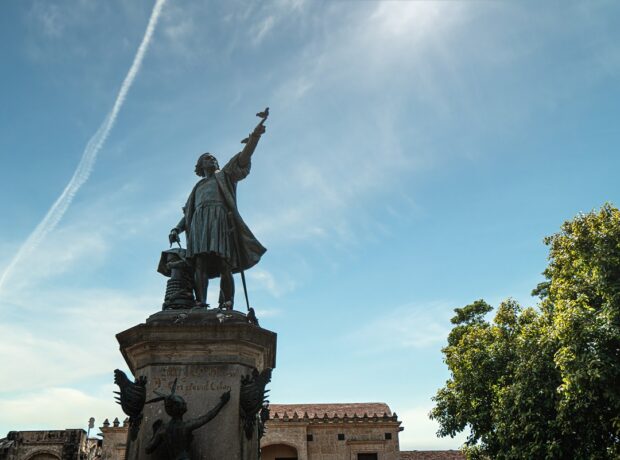Defaced, toppled over, or legally slated for removal: in the wake of the Black Lives Matter movement, statues linked to the slave trade have come into question. Protesters say these statues promote white supremacy by presenting racist figures as heroes. But is it right to uproot these pieces of history? If not, could they educate future generations about the brutality suffered by Black people?
While statues are falling, our latest story considers the future of buildings with a link to slavery, specifically the Market House in Fayetteville, North Carolina. We explore how the community is reckoning with its brutal history, asking whether the Market House, a structure once used to sell enslaved people, should survive and be re-purposed, or be demolished.
Below, we investigate how the UK, Canada and states in the US have responded to statues, monuments and buildings with a link to slavery.
United States
Georgia
In August 2020, amid the Black Lives Matter protests, Louisville City Council voted to remove the Market House that stands in the centre of town. Louisville’s Market House was built in the 1790s and was used to sell enslaved people, as well as land and goods.
The local historical society argued that the monument adds to the town’s historical value and say it can serve to teach visitors about the horrors of slavery. But the council received 70 letters about the Market House: 16 campaigning for its retention, 42 for its removal and the remaining containing different opinions.
South Carolina
The Old Slave Mart, built in Charleston in 1859, was turned into a museum of African American history, culture and arts in 1938. Some current members of staff at the facility have traced their heritage back to enslaved people who were auctioned off in the very building.
Instead of facing demolition or being repurposed with little or no acknowledgement of its past, the Old Slave Mart remains in Charleston to to tell the history of the city.
Read more about this story here.
Canada
Winnipeg
Last year, statues of Queen Victoria and Queen Elizabeth II were vandalised and removed amid growing outrage over the discovery of hundreds of unmarked graves belonging to Indigenous children found at mandatory residential schools where they were forcibly separated from their families, and many became victims of sexual and physical abuse. The discovery led many Canadians to question the colonial past of their country, when both monarchs ruled over these dark episodes of history.
Protestors wore orange clothing symbolising the Orange Shirt Movement, which stands in solidarity with the lost Indigenous children and their families. Amid demonstrations they chanted “no pride in genocide.” In the UK, a Downing Street spokesperson said: “We condemn any defacing of statues of the Queen. Our thoughts are with Canada’s indigenous communities following these tragic discoveries.”
Some demonstrators vandalised parish churches as 60% of the residential schools were run by the Catholic Church.
Read more about this story here.
United Kingdom
London
The uprising of the Black Lives Matter movement has led communities in the UK to reconsider the names of streets, buildings and schools linked with slave traders, while statues, plaques, and other memorials have been changed or removed. Likewise, British schools and universities have been found to omit Black people and Black history almost entirely from the curriculum. In 2019 Lavinya Stennett founded social enterprise The Black Curriculum to address the lack of Black British history in UK schools.
Monuments to William Beckford, a former London mayor, and John Cass, a member of Parliament, are to be removed and relocated, says the City of London Corporation. However, this move comes after the UK government announced new controversial laws aimed at safeguarding historic monuments across England. These new laws will apply to 20,000 similar statues and monuments with links to the slave trade.
Despite the new laws, the City of London Corporation has maintained its decision to remove the statues.
Read more about this here.
Bristol
On 7 June 2020, protestors tore down a statue of an English merchant and Member of Parliament with links to the slave trade, Edward Colston, and hurled it into Bristol harbour. This statue was originally erected in the centre of Bristol. The empty pedestal was later used a makeshift stage for protesters. Four protestors were charged with criminal damage after toppling the statue. But yesterday Sage Willoughby, Rhian Graham, Milo Ponsford and Jake Skuse were acquitted at Bristol Crown Court.
At the time of the toppling, home secretary Priti Patel called the act “utterly disgraceful” while historian Prof David Olusoga said: “Statues are about saying ‘This was a great man who did great things.’ That is not true, he was a slave trader and a murderer.”
Read more about this here.
Oxford
In June 2020, shortly after the toppling of Colston, the governors of Oriel College in Oxford voted to remove the statue of Cecil Rhodes, a colonialist with ties to the transatlantic slave trade. Protesters chanted “take it down” and then held a silence for 8 minutes and 46 seconds in memory of George Floyd.
Responding to the ‘Rhodes Must Fall’ campaign, many believe the statue should be removed to do away with ‘institutional racism’ but former Conservative MEP Daniel Hannan tweeted: “Rhodes’s generosity allowed thousands of young people to enjoy an education they could not otherwise have had…Why would anyone give to an institution that treats its benefactors this way?”
Oriel College later declined to move the statue due to costs and “complex” planning processes.
Read more about this here.
The arguments for and against
The following collection of videos takes into account arguments for maintaining historic monuments despite their links to slavery, removing but preserving them for posterity, and doing away with them completely.
What comes next?
If we reach the conclusion that racist statues and monuments should be removed, what should we replace them with?
Main image by Keir Gravil.
Read More:



